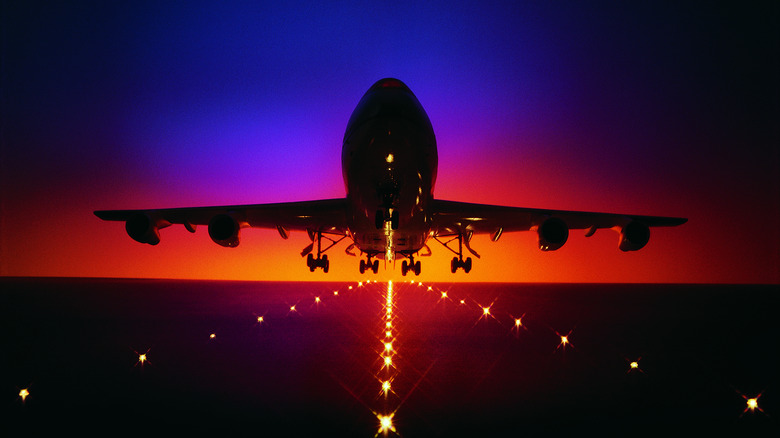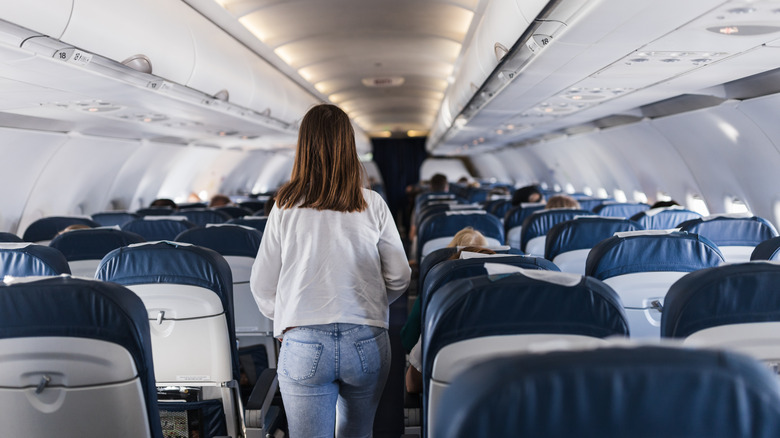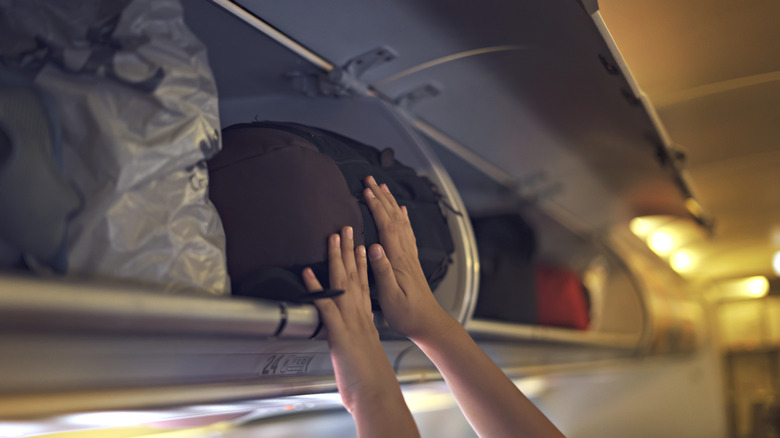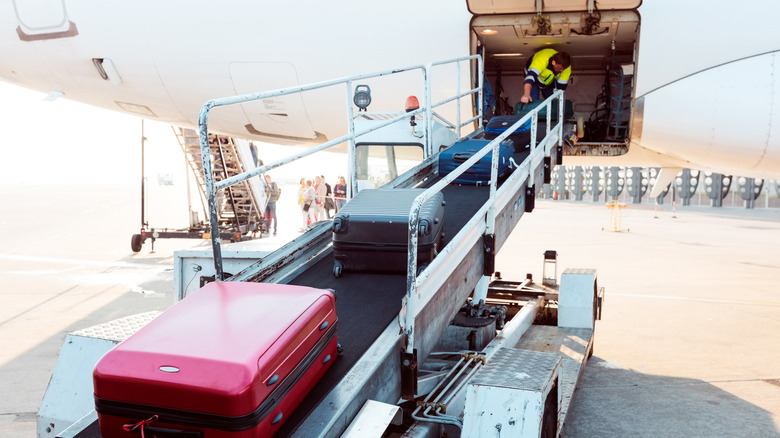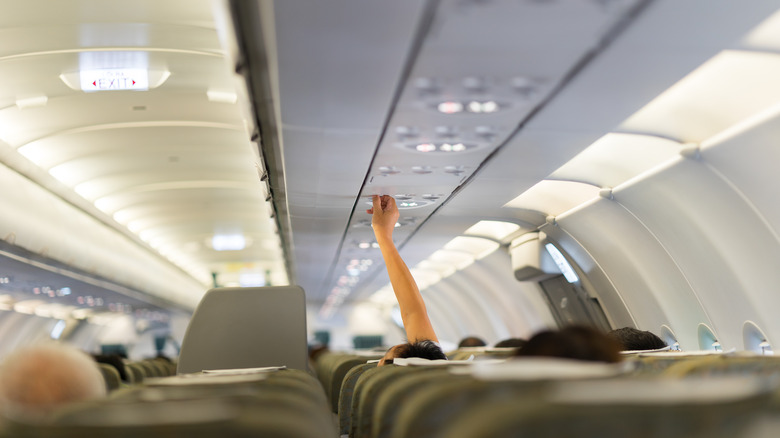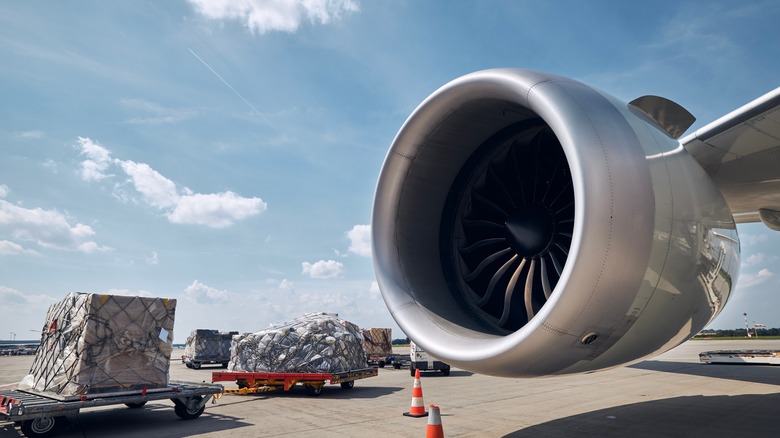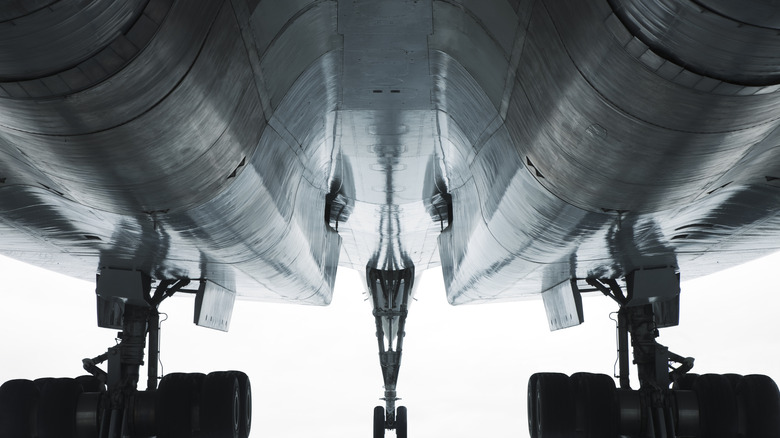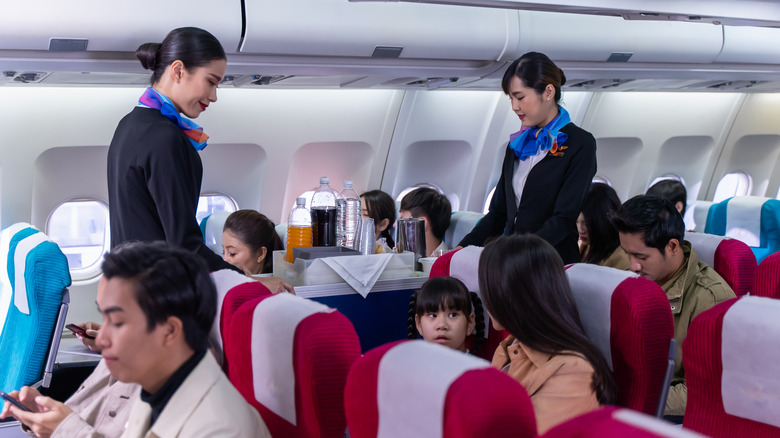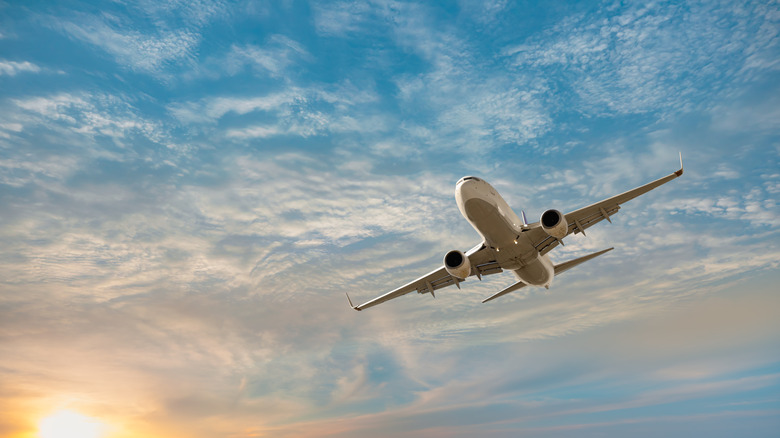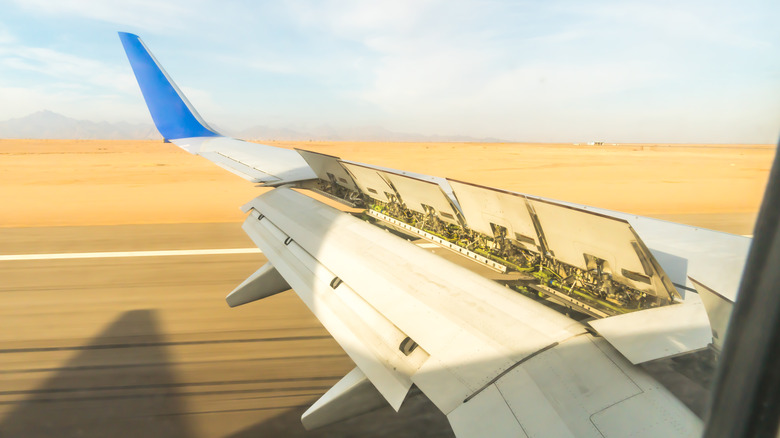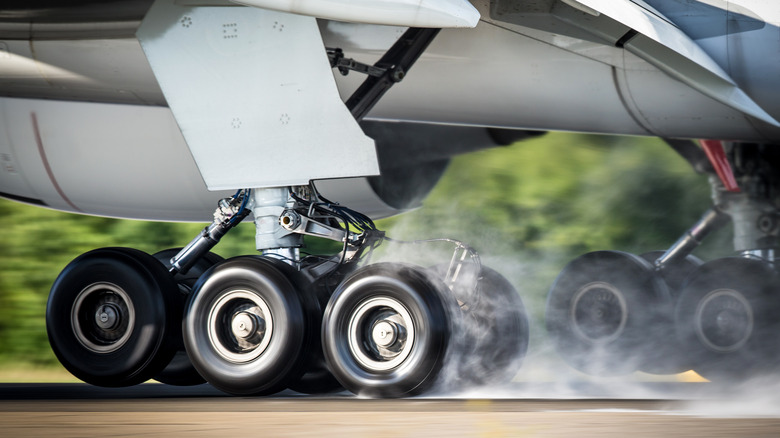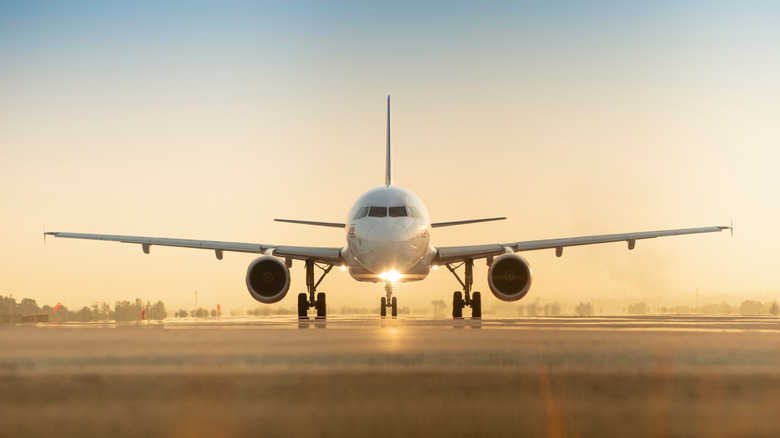17 Airplane Noises Explained (And Why You Shouldn't Worry)
Noise is an inevitable by-product of opposing forces, from the grrr-ing of thick bicycle tires rolling on the road to the cracking of our knees when we settle into an armchair. We are used to these sounds; they are habitual and not a cause for concern, but what about noises that aren't familiar? Unless you are an aircraft engineer, pilot, or frequent flier, sounds emanating from an airplane can feel alien and uncomfortable. This is especially true for the blips, beeps, whirs, and grinds that arise without context, detached from any identifiable pattern. And yet those sounds are actually run-of-the-mill, normal noises produced by a commercial piece of machinery that can weigh almost 400 tons and reach between 600 MPH to 700 MPH as it hurtles through the air.
It is this conundrum that makes fliers pause when they hear any peculiar sound. Could that click be the precursor to something serious thousands of feet above ground? Getting on a flight requires passengers to give up control of their fate, and once that happens, any soft murmur or unnatural sound will, of course, fray their nerves. But fear not; for every terrifying tone, there is a perfectly plausible explanation; read on, and you will feel reassured that the buzz, boom, or bleep on your next flight is nothing to fret over.
Humming at boarding
There are few quieter parts of an airport than the jet bridge that connects the terminal to the aircraft, which is strange considering that it's often choked with people expectant with excitement as they finally get onto the plane. That silence helps to amplify any actual sounds and assists passengers in hearing a low-grade buzzing or humming once they step inside the aircraft.
This isn't the sound of the cleaning crew using a leaf blower to tidy up the aisles or a yogi intoning a meditative chant. It results from an engine function that keeps the lights, electrical systems, and panels on before the plane's main engines are employed. Officially known as the auxiliary power unit, it is a small component that sits near the back of the aircraft and allows the vessel to deliver power to its non-flying pieces, a way to conserve fuel while keeping systems running. Think of it like listening to a car radio only using the battery.
Scraping and clanking while seated
You might encounter weird sounds once you've found your seat and settled into its narrow confines — or not so limited if you are a business-class passenger. A dull, heavy metal clanking, like a couple of swords clashing against each other, will probably occur when parts of the seat belt buckle, the lift-lever mechanism that connects to the two sides of the seat belt, smack against one another.
It's a harsh, off-putting, almost violent sound, given weight and power by the sturdy bulk of the assembly. Though these buckles are solid enough that they could do some serious damage, they do ensure that passengers of all shapes and sizes are secured safely when clipped in. You might also hear some odd scraping overhead, similar to an upstairs neighbor moving furniture in the middle of the night. This happens when passengers, or the crew, shift around bags in the overhead bin — made from a non-flammable, tough resin, nearly as durable as plastic — and is no cause for concern.
Thudding underneath your feet during boarding
This noise, which will be more obvious to passengers, occurs in the middle section of the plane, beneath the aircraft's torso. It resembles someone fumbling around in your basement, like a technician fiddling with the boiler or furnace or rearranging items. You should be able to guess this one, though if you haven't flown a lot, it might not be obvious. This happens when the luggage hold is ready to be filled with your valuable possessions, the bags you checked in at the airport desk or deposited at the bag-drop counter.
Baggage handlers will enter the hold and then stack pieces of luggage like Tetris blocks into the empty space — imagine putting suitcases in your car trunk, but at a much more rapid pace and with a whole lot more bags. First, a conveyor belt is placed on the edge of the cargo hold, and then bags are thrown onto it and transported into the recesses of the hold. That thumping sound could be the initial placing of the belt into the hold or, more likely, the sound of bags being tossed. Ahem, we mean gently placed on top of each other just below your seat.
Hissing before takeoff
Sometimes, you will trudge onto a plane, dodge the various bags and people in the aisles, and find your way to your seat only to notice how hot the aircraft is and how humid and oppressively still the air feels. Before a plane takes off, the air in the cabin is often pulled in from outside, so if it's steamy and sticky out, it probably will be inside as well. Some time before take-off, when the doors are closed and the cabin is ready, the air composition changes, resulting in a faint sound that only the sharpest ears might pick up.
This is the aircraft's ventilation system, comparable to air-conditioning, not just a fan that recycles the cabin air. Similarly, its hissing is not a leak in the plane, so don't worry. The air goes through a constant filtration process that cleans it before sending it back out via ducts that appear throughout the cabin. That air is often drier and possibly colder than you experienced when boarding. If that is the case, you might also notice a thin mist of air creeping into the cabin. Don't fear; this isn't an insidious way for the pilot to knock you out, but it is simple physics — when the cold air meets warmer air, it creates fine droplets that appear like mist.
Screeching, bumping, whirring, and droning after leaving the gate
For the plane to move, the main engines need to be engaged to get the bits of the aircraft that provide propulsion up and running. Since aircraft don't have a reverse gear, small, stocky vehicles push them back from the gate to the necessary position so they can advance. Once in place, the engines will start to fire up, resulting in a screeching sound just below the wings, where the jet engines are located. Once it has clearance, the plane will start to move toward the runway, and en route, its wheels will ride over strips, cracks, and joints in the tarmac (imagine a car riding over a bump or pothole in the road but with the weight and force amplified).
As the plane prepares to take off, flaps on the wings are extended as part of the process, and this will explain the whirring (think a giant blender) that you'll hear as they move into position. When the pilot engages forward thrust, you will notice a dull, deep, droning sound, and you will feel the immense power of the aircraft ready to be unleashed as the intensity of the engines ramps up. The sound will be loud, forceful, and steady, like an extended growl, though with a higher and whinier pitch.
Thumping after lift off
Once the plane lifts off the runway and everything below becomes smaller, the aircraft climbs at a steep angle and calm descends over the cabin. This is surely one of the most thrilling sections of a flight, the chance to get a bird's-eye view of a city or island. But wait, what is that strange thumping sound, an awkward, violent noise that suggests something is stuck as it valiantly attempts to get back in position? Put your mind at ease, for this sound, which only happens when the aircraft is near its point of departure or arrival, signifies that the wheels are hydraulically returning or withdrawing.
Unlike a car, the wheels aren't always needed but are tucked into the plane's body during the flight (they serve no purpose in the air and would create extra drag by being left in the down position). When they fold back into place, pivoting like a section of origami paper, the compartment doors close over them, causing the thump.
Chiming and rumbling during the flight
The constant drone of the engines in flight, coupled with idle passengers confined to tight positions, often leads to an airborne haze, a fleeting slumber that can last minutes or hours. During these moments of shut-eye, you might find yourself woken by a high-pitched pinging chime, a bit like the sound that an elevator makes when it reaches a prescribed floor. This is not an alarm or a warning against impending doom but will be the sign that a passenger has requested the attention of a cabin crew member. The sound is typically accompanied by a light illuminating the passenger's seat.
Passengers will hear a similar sound when a crew member activates or deactivates the sign that requires them to keep their safety belts on — but, again, this doesn't mean a calamity is about to unfold. If you hear a rumbling, and it's not coming from your stomach or anyone nearby, it will, coincidentally, be food-related — the food and beverage cart will slowly be making its way down the aisle.
Silence before landing
During the flight, there is a momentary pause in the constant hum of the aircraft's engine just before landing. That intermission in sound can almost feel like the pilot has turned everything off, and the aircraft is floating, or drifting, unpowered. For some fliers, it accompanies this strange, slightly uneasy sensation that almost resembles weightlessness, that the plane just seems to be hovering in mid-air. It's akin to that brief moment in skydiving after the parachute is deployed and you feel suspended in the atmosphere, though still falling.
The impression of levity occurs when the aircraft's thrust is lowered, reducing the plane's speed in preparation for arrival at the destination. In the air, a plane can travel at an excess of 600 MPH, but when it lands, the speed needs to be less than 170 MPH, so pilots need to decelerate before touching down. If you hear that lull in sound and feel like you are resting on a cloud, just picture that the pilot has momentarily taken his foot off the gas (figuratively, not literally) and know that landing is likely not far behind.
Groaning, banging, and vibrating during descent
By now, you should be able to recognize a few of the noises that have popped up during the flight. As the plane starts to wind up its journey, and you look forward to arriving at your destination, some of those noises you heard earlier will make a cameo again. Toward the end of the flight, you might make out a faint whirring when the flaps at the back of the wing are again extended in preparation for landing.
This will be followed by a passage of groaning and some banging, hinting that the compartment doors for the wheels are opening and the wheels are coming down to lock into place. Just before landing, there will be more whirring and vibrating when the spoilers and flaps in the middle of the wing are raised. This allows the aircraft to increase the resistance area of the wings, which will help it slow down more quickly once it lands.
Screeching upon touchdown
When the plane lands, the flight crew deploys measures to decelerate the vessel. As mentioned earlier, various appendages of the aircraft are pushed outward, creating more drag that naturally slows the plane down. When the plane first touches the runway, the force and impact are massive, and the tires don't simply roll forward at touchdown but skid a little as the aircraft gains traction. The friction of the rubber landing on the tarmac can make a squeaky, yelping sound. Yes, the result is skid marks on the runway.
After landing, the pilot will smoothly apply the brakes to decelerate the aircraft in a steady and constant manner instead of abruptly stopping it. This is possible due to the well-calibrated braking mechanisms. Once the plane reaches a sufficient speed, the back wing flaps will be returned to their previous position, resulting in the familiar and calming whirring sound.
Roaring on the runway
At about the same time the brakes are applied, passengers might get a little frightened by a mighty roar from the engines, suggesting that the pilot is getting the aircraft ready to take off. Oh no, the aircraft has been hijacked! Nothing could be further from the truth, though that thundering sound does come from the engines. It happens because they are engaged in reverse thrust, another weapon in the arsenal of measures that a pilot has to slow the behemoth down. That growl might last some time because the plane needs to decelerate from the fast landing clip to a pace at which it can safely pull off the runway and comfortably navigate the taxiways that lead to the terminal.
Inside the aircraft, you might hear beeps and chimes as other fliers turn on their phones and receive chats and messages. Once the plane has slowed down sufficiently, you shouldn't hear any roaring sound again. If you do, it will be from other flights readying to take off, filled, perhaps, with passengers second-guessing every squeak, slam, and smack. The only aircraft sound you should keep your ears open for at this point is the chime that signifies that you can take off your seat belt and that your journey is at an end. Sounds like a cause for celebration.
